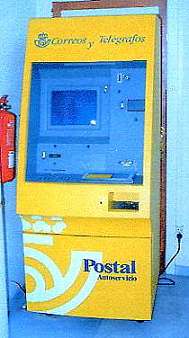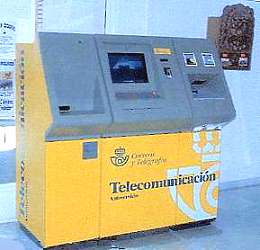 |
The
new machines, equipped with touch screens, were of two types : Postal
( called Autómata I
) and communications machines ( Autómata
II ) :
The
postal self-service IBM machine was programmed to sell ATMs
or variable value stamps ( Klüssendorf type ) and prefranked
postal cards, and was equipped with a balance. Also it could offer information
on telegraphic and postal services, philately, new items, postal tariffs
and codes, Post offices, publications and announcements.
The
AT&T communications machine included one scanner and allowed
the shipment of telegraphic and postal order, to send a fax or a national
or international telegram, as well as to ask for the acquisition of philatelic
items. Also it could provide identical information that the postal machine
and still more complex operations, as the pursuit of Express shipments,
to formulate claims, suggestions and other questions.
This
great postal project proposed the installation of 100 self-service machines
( 50 of each type, with an investment of more than 700 million pesetas
) in 10 Spanish provinces ; provinces with high demography or important
tourist infrastructure, Post offices with a high volume of correspondence,
commercial centres, airports and railway stations, and places where the
attention to the post users was insufficient.
In
all of this self-service machines it was possible to pay with coins and
banknotes, but in theory also with credit cards, and they gave a receipt
of the purchase.
Finally
all the expected machines were not installed and it seems that they had
many problems of operation and maintenance ; An incredible failure that
culminated with the removal of all the machines installed in Spanish geography. |

